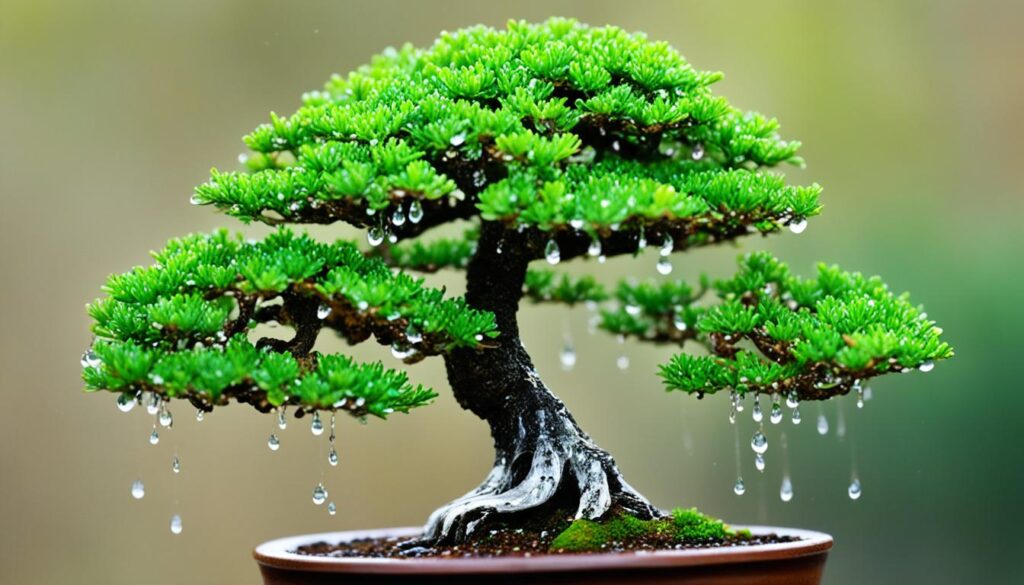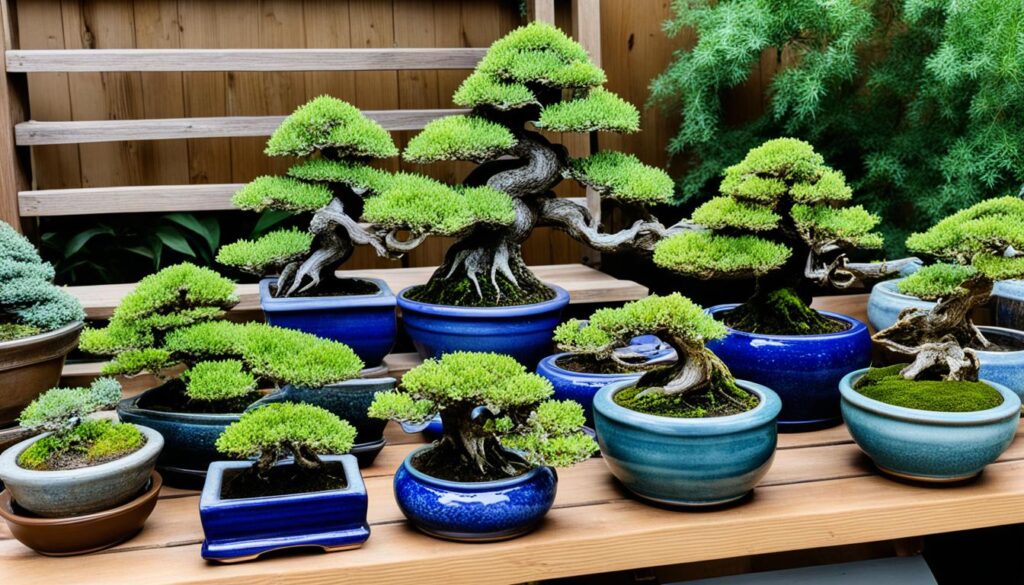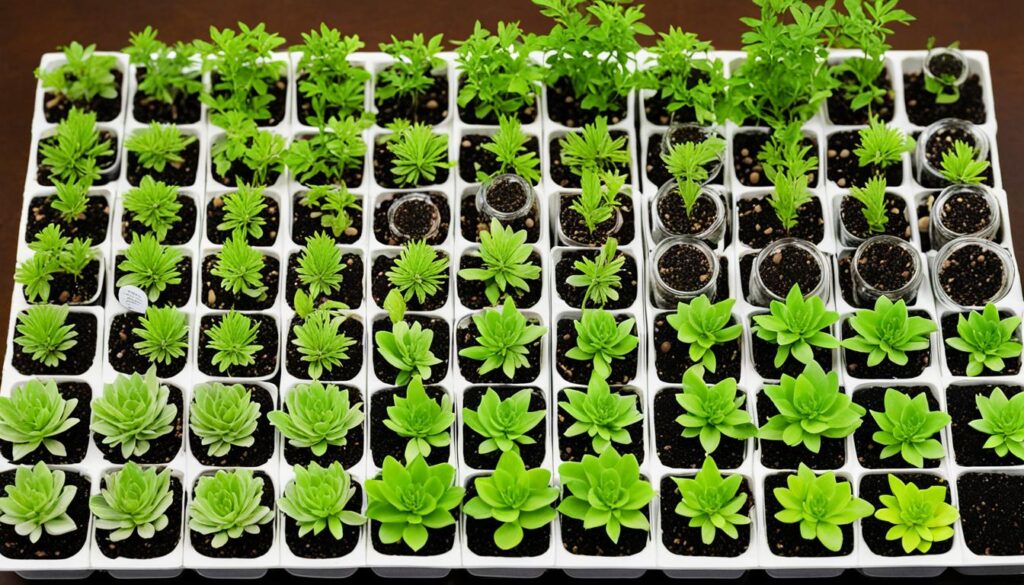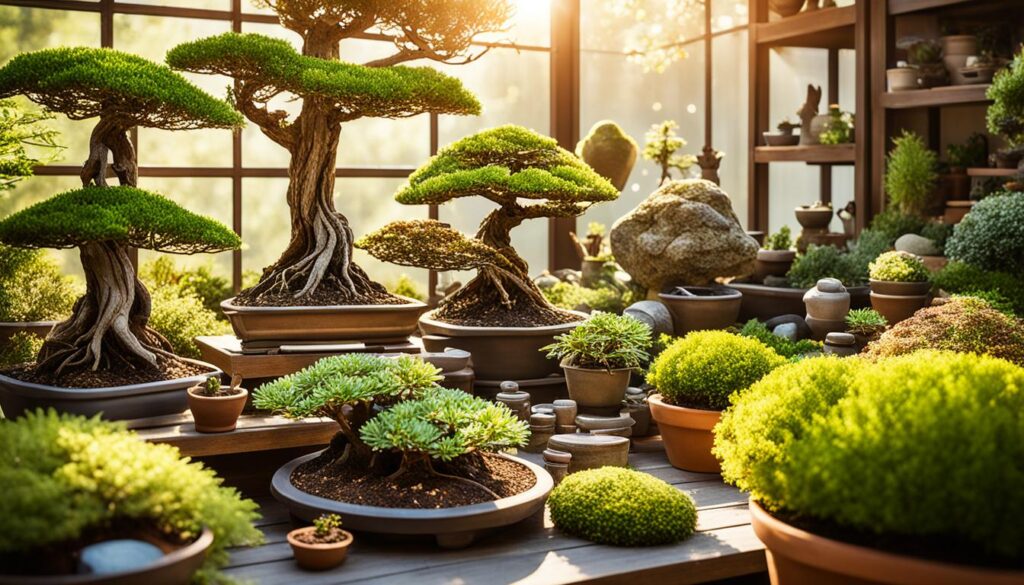Did you know there are over 2,500 bonsai shops in the U.S.? This ancient art has been around for over 1,000 years. Bonsai Supply is your go-to place for all bonsai tree care needs. We offer a wide range of high-quality supplies to help you grow healthy, beautiful miniature trees.
Key Takeaways
- Bonsai Supply is your one-stop shop for a wide range of bonsai tools, pots, soil, fertilizers, and accessories.
- Our team of bonsai experts is dedicated to providing you with the knowledge and resources to care for your miniature trees with confidence.
- We offer a diverse selection of bonsai trees, including coastal redwoods, oaks, junipers, and azaleas, to suit your preferences.
- Bonsai Supply provides retail stores, mail orders, and online ordering options for your convenience.
- From watering and feeding to pruning and wiring, we have all the essential supplies and guidance to help you master the art of bonsai.
What is a Bonsai Supply?
A bonsai supply is a store or online shop that sells products and accessories for bonsai trees. These stores help bonsai lovers with the tools, pots, soil, and more they need. They keep the trees healthy and looking great.
Understanding the Bonsai Essentials
To keep a bonsai alive and beautiful, you need to know the basics. This means learning how to water, feed, prune, and wire the tree. Bonsai supply stores teach these important skills. They help bonsai owners make their trees thrive.
Importance of Quality Supplies
Choosing the right bonsai supplies is key to your tree’s health and look. Things like special bonsai tools, top-notch bonsai pots, and the best soil matter a lot. Good bonsai supply stores have all these things and more. They make it easy for bonsai fans to find what they need.
“The secret to successful bonsai lies in the quality of the supplies you use and the care you provide.”
For both new and experienced bonsai lovers, a trusted bonsai supply store is a big help. They offer the right bonsai essentials and teach how to care for them. This helps the bonsai community grow and enjoy their hobby more.
Watering Your Bonsai
Proper watering is key to bonsai care. Bonsai trees need water differently than full-size trees. They require a balance to stay healthy and live long. Learning how to water bonsai trees right is crucial for their success.
Proper Watering Techniques
Use a watering wand or can with a soft shower setting for your bonsai. This gentle method makes sure the soil gets soaked without harming the roots. For bonsai outside, water them every day before 11 am. This lets the moisture evaporate before it’s too hot.
For indoor bonsai, water them every 3-4 days or when the top soil feels dry. The best soil mix for bonsai has akadama, pumice, and lava rock in a ┬Į to ┬╝ to ┬╝ ratio. This mix prevents overwatering, which can cause root rot.
When you water, make sure to soak the roots well. Water should flow out of the drainage holes at the bottom.
Signs of Over or Under-Watering
It’s important to watch how much water your bonsai needs. Too much water can harm the tree, and so can too little. Look out for yellow leaves with black spots if you’re watering too much. Brown, wilting leaves mean you’re not watering enough.
Experts say don’t water bonsai trees the same way every time. Watch each tree to see what it needs. Finding the right balance in watering is key to healthy growth.

“Watering a bonsai tree is an art that requires patience, observation, and a deep understanding of the individual tree’s needs.”
Feeding Your Bonsai
Keeping your bonsai tree healthy is key, and regular feeding is a big part of that. Bonsai fertilizer gives your tree the nutrients it needs to grow and stay strong.
Experts say to feed your bonsai with a good bonsai fertilizer once a month when it’s growing. How much and how often you feed depends on your bonsai’s size, age, and where it is in its growth cycle.
For the best results, choose a bonsai nutrition mix with an NPK ratio of 6:6:6. This mix has the right balance of nutrients to keep your bonsai healthy. It helps with strong roots, lots of leaves, and healthy growth.
“Proper fertilization is essential for the long-term health and development of your bonsai tree. It provides the necessary nutrients to sustain its growth and ensure it reaches its full potential.”
When you’re adding bonsai fertilizer, think about the size of your bonsai pot. Use about 1 teaspoon of fertilizer for every 4 inches of pot size. This way, your tree gets the right amount of nutrients without getting too much.
Remember, different bonsai trees have different needs. Their needs change based on their type, growth stage, and where they live. Talk to bonsai experts or look up reliable advice to find the best bonsai feeding plan for your tree.
Stick to a regular bonsai feeding plan and use a top-notch bonsai fertilizer. This way, your bonsai gets the nutrients it needs to do well. Good bonsai nutrition is key to taking care of your bonsai right.
Understanding Leaf Discoloration
Keeping your bonsai’s leaves vibrant is key to its health and beauty. Leaf discoloration can happen and signal problems that need fixing. Knowing why leaves turn yellow or brown helps you fix the issue and keep your bonsai healthy.
Why Leaves Turn Yellow
Yellow leaves on your bonsai can mean several things, like too much water or not enough nutrients. Bonsai yellow leaves might show chlorosis, a lack of chlorophyll. This can come from too much water, not enough light, or poor soil nutrients.
- Too much water can cause chlorosis, making leaves turn yellow.
- Not enough water can also make leaves yellow as the bonsai saves water.
- Not enough sunlight can lead to pale yellow leaves from chlorosis.
- Lacking nutrients like nitrogen or iron can change leaf color and growth.
Why Leaves Turn Brown
Bonsai brown leaves often mean your bonsai is stressed, usually from not enough water or environmental issues. Brown leaves can also happen naturally in deciduous bonsai trees that lose their leaves in fall.
- Not enough water can make leaves brown as the bonsai can’t keep moisture.
- Too much sunlight, low humidity, or cold can also turn leaves brown.
- Pests, diseases, or not enough nutrients can cause bonsai leaf discoloration, making leaves brown or discolored.
- Deciduous bonsai trees naturally lose their leaves in fall, showing autumn colors before turning brown and falling off.
Knowing why leaves turn yellow or brown helps you fix the problem. Regular checks, right watering, and balanced food are important to stop and fix leaf discoloration in your bonsai.

“The secret to maintaining healthy, vibrant bonsai foliage lies in understanding the nuances of leaf discoloration and addressing the root causes with diligence and care.”
Bonsai Tools and Accessories
Keeping a bonsai tree healthy and beautiful needs the right tools and accessories. These tools help with shaping, pruning, wiring, and potting. Let’s look at the key bonsai tools and accessories that improve your bonsai care.
Essential Bonsai Tools
Having the right tools is key to bonsai care. Here are some must-have bonsai tools:
- Bonsai pruning shears – These shears are made for making clean cuts on small bonsai branches and leaves.
- Concave cutters – For cutting off big branches, these cutters make smooth cuts that help the tree heal and grow back well.
- Wire cutters – These are crucial for putting on and taking off bonsai wire. Wire shapes and trains the tree’s growth.
- Root hooks – These tools help untangle and trim the roots of bonsai trees when you repot them.
Bonsai Accessories for Better Care
There are also accessories that can make bonsai care better. Here are some useful ones:
- Humidity trays – These trays keep the right humidity levels around your bonsai, which is key for its health.
- Bonsai wire – This wire is used to shape and train the bonsai branches into the look you want.
- Moss – Moss can be used to make your bonsai look better by covering the soil.
- Bonsai soil – A good soil mix that drains well and has nutrients is vital for your bonsai’s growth and health.
“Proper bonsai tools and accessories are essential for the successful care and maintenance of your miniature trees.”
Investing in the right bonsai tools and accessories helps your bonsai trees do well. Whether you’re experienced or new to bonsai, the right gear makes a big difference in caring for your trees.
Choosing the Right Bonsai Pots
Choosing the right bonsai pot is key to your tree’s health and growth. There are many shapes, sizes, and materials for bonsai pots. Each one is best for certain trees and growth stages. The right pot size, depth, and drainage help your bonsai flourish.
Many factors influence bonsai pot selection. Ceramic and porcelain pots are classics, keeping moisture in and offering many designs. Oval and rectangular pots are usually 2/3 the tree’s height, while round or square pots are 1/3 the height. This ratio keeps your bonsai balanced and in proportion.
The type of bonsai tree also affects pot choice. Trident maples and other fast-growing trees need deeper pots. For trees with sparse branches and thick bark, masculine pots work well. Feminine pots suit trees with curved trunks.
“Bonsai pots are shallower than regular plant pots and often include drainage and wiring holes for proper maintenance.”
When picking a bonsai pot, think about the tree’s look and the effect you want. Glazes match the tree’s colors, with brown, gray, and earth tones popular. Choose pots that match the tree’s seasonal colors, like gray for deciduous trees or mottled glazes for variety.
Choosing the right bonsai container is vital for your bonsai’s health and growth. By knowing your tree’s needs and picking the right bonsai pot, your bonsai will flourish for many years.

Bonsai Supply: A Wide Selection
At Bonsai Supply, we’re proud to offer a wide range of bonsai products. Our bonsai nursery has many bonsai trees for different tastes and skills. Whether you’re new to bonsai or have been doing it for years, we have something for you.
Our bonsai inventory includes a variety of bonsai trees, each with its own look and growth. You’ll find everything from delicate Japanese maples to tough junipers. Our team is ready to help you pick the best bonsai for your space and skill level.
We also have all the tools and accessories you need for bonsai care. This includes things like precision pruning shears, wire benders, and special soil and fertilizers. We make sure you have the best bonsai supply selection to help your bonsai thrive.
Whether you’re just starting or you’re a pro, Bonsai Supply is your go-to place for bonsai. Check out our bonsai nursery and find the perfect trees to add to your collection. Let us help you create stunning bonsai art.
Bonsai Soil and Fertilizers
The success of your bonsai tree depends a lot on the quality of the bonsai soil and fertilizers. Using the right soil and fertilizers is key for growth, healthy leaves, and your bonsai’s overall health.
Importance of Proper Soil Mix
Bonsai trees need a special soil mix that drains well. The best mix includes akadama, pumice, and organic matter. This mix helps with aeration, keeping nutrients, and draining water, which are vital for your bonsai.
Fertilizing for Optimal Growth
Feeding your bonsai with a balanced fertilizer is crucial for its nutrition and healthy leaves. A good fertilizer gives the right nutrients for strong roots, healthy leaves, and your bonsai’s unique look.
With the right bonsai soil and nutrition, your miniature tree will thrive and look great for many years.

“The secret to growing healthy bonsai lies in the soil and the right bonsai fertilizers.”
Bonsai Pruning and Wiring
Learning bonsai pruning and bonsai wiring is key to keeping your mini trees looking great. Pruning helps control the tree’s growth and shape. Wiring lets you bend branches to get the perfect look.
Techniques for Shaping Your Bonsai
Pruning bonsai is a precise task that needs thought. Here are some important tips:
- Thinning – Cutting some branches to let more light and air in.
- Trimming – Snipping leaves and twigs to keep the tree’s shape and size right.
- Branch Removal – Taking out branches to control the tree’s energy and shape.
Wiring your bonsai is a key skill. It lets you shape the tree’s branches for the look you want. You wrap wires around branches to guide their growth. This needs patience and care to avoid harming the branches.
For more on bonsai pruning and bonsai wiring, check out our bonsai care supplies at Bonsai Supply.
“The true art of bonsai lies in the precision and care with which you shape and style your miniature trees.”
Indoor vs. Outdoor Bonsai Care
Growing bonsai trees indoors or outdoors changes their care needs. It’s key to know these differences for their health and growth.
Indoor Bonsai Care
Indoor bonsai, like the Ficus Bonsai, need careful watering and lighting. Tropical species like the Dwarf jade and Fukien tea are great for indoors because they don’t sleep like temperate trees. But, they have small pots, so they need more water and nutrients.
They need lots of light, sometimes extra artificial light. Keeping the air around them moist is also important. You can use trays, misting, and fans to do this.
Outdoor Bonsai Care
Outdoor bonsai get sunlight and change with the seasons. Trees like maples and junipers do well outside, needing to sleep in winter. They need water every day when they’re growing and protection from harsh weather.
When to repot them is different too. Indoor bonsai in spring or early summer, and outdoor ones in late winter or early spring.
Whether indoors or outdoors, watering, feeding, and watching for pests are key. Knowing what each environment needs helps your bonsai thrive.

“Bonsai gardening requires special tools that are essential for the care of these plants.”
- The Bonsai Outlet gives bonsai care guides with each tree to help beginners.
- With the right care, bonsai trees are easy to keep. They shouldn’t just be decorations.
Seasonal Bonsai Care Tips
Caring for your bonsai is a year-round task. The needs of your miniature trees change with the seasons. Knowing what each season requires will help your bonsai stay healthy and beautiful. Let’s look at the seasonal care tips to keep your bonsai plants looking great.
Spring and Summer Care
In spring and summer, your bonsai grows the most. To support this growth, focus on these key areas of bonsai seasonal care:
- Increased watering to keep the soil moist
- Plenty of sunlight
- Regular feeding with a balanced bonsai spring care or bonsai summer care fertilizer
Watch your bonsai’s water needs closely in the warm months. They can dry out fast. Check the soil often and water when it gets dry, but don’t overwater.
Fall and Winter Care
When seasons change, your bonsai starts to sleep. In bonsai fall care and bonsai winter care, adjust your care to help them through the cold:
- Water less often to let the soil dry out
- Keep your bonsai safe from harsh winds, frost, and snow
- Avoid heavy pruning or repotting when they’re dormant
- Give them a light feeding with a bonsai fall care or bonsai winter care fertilizer
Understanding your bonsai’s needs in each season is key to their health. With the right care, your miniature trees will flourish all year.
Bonsai Seeds and Starter Plants
Starting your bonsai journey can begin with bonsai seeds or young bonsai starter plants. Growing bonsai from seed lets you see your trees grow from the start. Or, you can start with nursery-grown plants for a quicker beginning.
Bonsai Supply knows the joys and challenges of growing bonsai. We offer a wide selection of top-quality bonsai seeds and starter plants. This helps you, no matter your bonsai experience.

Our store shows that 60% of our customers like to start with bonsai seeds. The other 40% choose young starter plants. About 35% buy both seeds and starter plants. They try different ways to grow their bonsai trees.
No matter your choice, Bonsai Supply is here to help you succeed. We offer the best bonsai seeds and starter plants. Start your bonsai adventure with us today!
Troubleshooting Common Bonsai Issues
Bonsai lovers know the joy of caring for these small trees. But, bonsai can sometimes face problems. At Bonsai Supply, we’re here to help you spot and fix common bonsai issues. This ensures your plants stay healthy and vibrant.
Pest and Disease Management
Pests and diseases can harm bonsai trees. Common bonsai pests include aphids, spider mites, weevils, and mealybugs. These pests can damage leaves and harm your tree’s health. It’s important to catch and manage pests early.
Look out for signs like ragged leaf edges, bite marks, and leaves that wilt or fall off seasonally. You might also see egg sacks under leaves. If you spot these, act fast to fix the issue.
Our experts suggest removing pests and using proper insecticides for prevention. This method gets rid of pests and keeps your bonsai healthy. By following our advice, you can bring back the beauty of your trees.
Diseases can also affect bonsai. Symptoms include yellowing leaves, shriveling, and peeling bark. Diagnosing and treating with fungicides can help manage these problems.
Being good at troubleshooting and problem-solving is key for bonsai lovers. With the right advice and care, you can beat bonsai pests and diseases. This keeps your bonsai collection healthy and beautiful.
“The key to successful bonsai care is understanding and addressing issues as they arise. With the right knowledge and resources, you can keep your miniature trees thriving for years to come.”
Bonsai Classes and Services
At Bonsai Supply, we offer top-quality bonsai supplies and educational resources. Our classes and workshops are led by pros. They teach you how to prune, wire, and repot bonsai. These bonsai education sessions are great for beginners and pros alike.
We also have bonsai services for extra help with your bonsai care. Our bonsai boarding program gives you expert bonsai care guidance when you’re away. This lets you relax, knowing your bonsai is well taken care of.

Looking to learn more about bonsai or need help with your bonsai? Bonsai Supply is here for you. We offer top-notch bonsai services and resources. This makes your bonsai journey rewarding and fulfilling.
“Bonsai Supply’s classes and services have been instrumental in my bonsai journey. The hands-on training and expert guidance have helped me take my hobby to new heights.”
Check out our bonsai classes and services today. With Bonsai Supply, you can make the most of your bonsai. Enjoy the beauty and peace these trees bring for years.
Conclusion
At Bonsai Supply, we’re your go-to spot for everything bonsai care related. We offer a wide range of top-notch bonsai supplies, helpful resources, and expert services. Our goal is to help bonsai lovers of every level grow and care for their tiny trees with ease.
If you’re an expert or just beginning, come explore bonsai with us at Bonsai Supply. Our team is ready to give you the bonsai resources and support you need. We want to help you grow your love for this unique art.
We provide everything from the best bonsai pots and tools to advice on watering, feeding, and pruning. Bonsai Supply is here to be your ally in bonsai excellence. Let’s shape the future of bonsai together, building a community that values the beauty and peace of these tiny trees.


